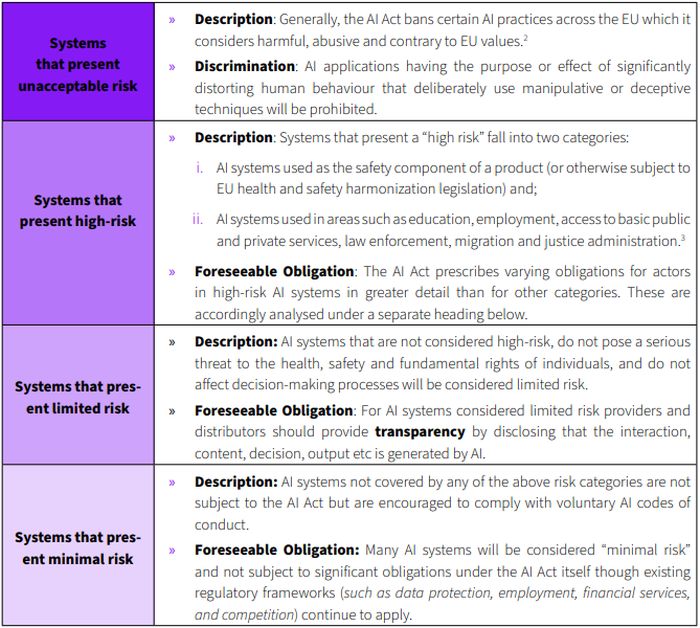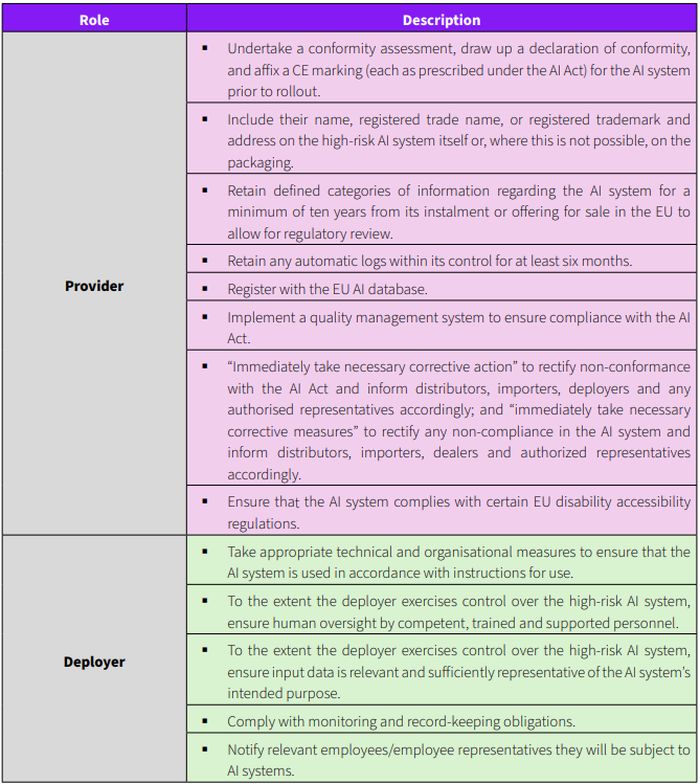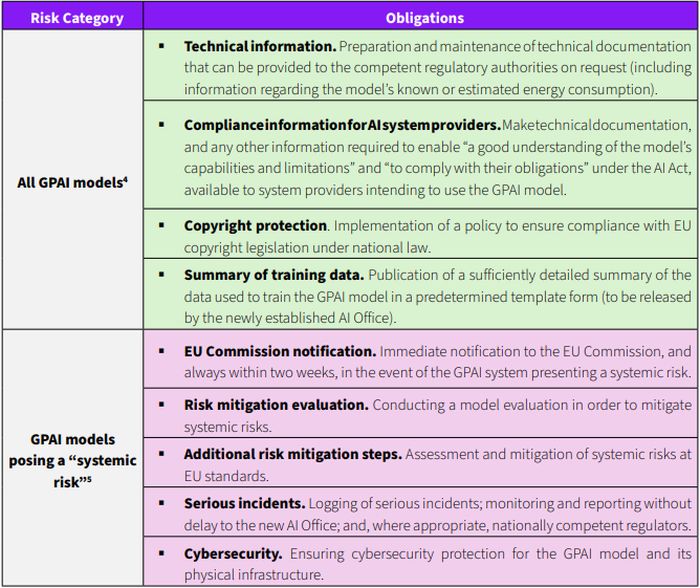To print this article, all you need is to be registered or login on Mondaq.com.
Overview
Artificial intelligence (“AI“)
systems, which have recently become increasingly widespread in
almost every sector, are machine-based computer systems designed to
operate with varying levels of autonomy and demonstrate
adaptability after deployment. AI systems process inputs to achieve
explicit or implicit goals and produce outputs such as predictions,
content, recommendations or decisions that can affect physical or
virtual environments.
The European Union (“EU“) Artificial
Intelligence Act (“AI Act“), the
world’s first comprehensive legislation aimed at regulating the
sector, was adopted by the European Council on May 21, 2024 after
long periods of negotiation and legislative preparation and entered
into force (directly for EU member states) on August 1, 2024.
Harmonization transition periods are envisaged to last two years
and will vary according to associated risk levels. AI systems
presenting an “unacceptable risk” will be banned within 6
months of the Act’s implementation, while certain obligations
for “General Purpose Artificial Intelligence”
(“GPAI“) systems, as defined below, will
apply after 12 months. Implementation of provisions for high-risk
AI systems will begin on August 2, 2027.
The AI Act covers all stages of “AI systems, from
development to use and aims, to ensure AI is a regulated and
trusted mechanism and to encourage investment and innovation in the
field. Within the framework of the AI value chain1 , it
applies to providers (developers and companies instructing
development), importers, distributors, manufacturers and
deployers of certain types of artificial intelligence systems.
The AI Act’s obligations vary according to roles played in
the AI value chain with a focus on providers, distributors,
importers and manufacturers of AI systems. Depending on
the level of threat posed to humans, AI systems are categorized as
presenting “unacceptable risk“,
“high-risk” and “limited
risk“. Violations are subject to fines at the following
scales: (i) €35,000,000 or 7% of worldwide annual turnover
(unacceptable risk); (ii) €15,000,000 or 3% of worldwide
annual turnover (high risk); and (iii) €7,500,000 or 1% of
worldwide annual turnover (limited risk).
Who are the actors under the new Act?
Obligations under the new law will differ according to the
following roles in the “AI value chain”, defined by the
Act as “operators”, with most falling on providers of AI
systems:
The European Commission will delegate its powers for effective
implementation of AI Act obligations to the AI office to be
established (without prejudice to agreements between EU Member
States and the EU) which will take all actions necessary for
effective implementation.
Are only EU companies affected?
The AI Act will employ extra-territorial jurisdiction similar to
the European Union’s General Data Protection Regulation
(“GDPR”):
- Businesses supplying AI systems within the EU (regardless of
whether they are established in the EU or not) and; - Businesses located outside of the EU if the output of their AI
system is used within the EU
The AI Act imposes direct obligations on providers
(developers of AI systems), deployers, importers,
distributors and manufacturers of AI systems operating within the
EU in connection with the EU market but also applies
extraterritorially to non-EU companies. Therefore, providers must
comply with its provisions when placing their AI systems or GPAI
models on the market, or putting them into service in the EU,
regardless of their location. Importers, distributors and
manufacturers serving the EU market will also be affected:
- providers placing or servicing AI systems in the EU market or
placing GPAI models in the EU market; - deployers of AI systems who have a place of establishment or
are located in the EU and; - providers and deployers of AI systems in non-EU countries where
the output produced by the AI system is being used in the EU.
What are the risk levels?
In order to implement the Act’s provisions proportionately
and effectively, a risk-based approach has been adopted under which
AI systems have been categorized according to the scope of the
risks each may pose.

Obligations for High-Risk AI Systems
The AI Act imposes a wide range of obligations on providers for
AI systems deemed to be “high risk” including risk
assessments; maintaining governance and documentation; public
registration and compliance assessments; and prevention of
unauthorized modifications.
Deployers are required to comply with significantly more limited
obligations such as implementation of technical and organizational
measures to comply with usage restrictions and ensuring competent
human oversight.
High-risk AI systems must also undergo a conformity assessment
before being placed on the market or put into service. This process
includes the establishment of a monitoring system and reporting of
serious incidents to market surveillance authorities.
They are also subject to comprehensive compliance requirements
covering seven main areas:
- Risk management systems. These must be
“established, implemented, documented and maintained”.
Such systems must be developed iteratively and planned and run
throughout the system’s entire lifecycle while subject to
systematic review and updates. - Data governance and management
practices. Training, validation and testing data sets
for highrisk AI systems must be subject to appropriate data
governance and management practices. The AI Act sets out specific
practices which must be considered including data collection
processes and appropriate measures to detect, prevent and mitigate
biases. - Technical documentation. A requirement to
draw up relevant technical documentation before a high-risk AI
system is placed on the market or “put into service”
(i.e. installed for use) and ensuring it is kept up to date. - Record keeping/logging. High-risk AI
systems must “technically allow for” recording of
automatic logs over the lifetime of the system to ensure system
functioning maintains an appropriate level of traceability for its
intended purpose. - Transparency / provision of information to
deployers. High-risk AI systems must be designed and
developed to ensure sufficient transparency to allow deployers to
interpret output and utilise it appropriately. Instructions for use
must be provided in a format appropriate for the AI system. - Human oversight. “Natural persons”
must oversee high-risk AI systems with a view to preventing or
minimising risks to health, safety, or the fundamental freedoms
that may arise from their use. - Accuracy, robustness and cybersecurity.
High-risk AI systems must be designed and developed to achieve an
appropriate level of accuracy, robustness and cyber security and to
perform in accordance with these levels throughout their
lifecycle.
Providers based outside the EU
are required to appoint an authorized representative based in the
EU.
Providers must ensure their high-risk AI systems comply with the
requirements set out above and must demonstrate compliance when
reasonably requested to do so by a national competent regulator
(providing information that is reasonably requested).
Providers and deployers of high-risk AI systems
must also:

General Purpose Artificial Intelligence (GPAI) Models
The AI Act sets out a specific section for the classification
and regulation of GPAI models which are defined as “AI
model(s) that exhibit significant generality, including when
trained with large amounts of data using large-scale
self-supervision, and capable of competently performing a wide
range of tasks, regardless of how the model is released, and which
can be integrated into various downstream systems or applications
(with the exception of AI models used for research, development or
prototyping activities prior to release)“.
Though GPAI models are essential components of AI systems, they
cannot constitute AI systems on a standalone basis. Examples
include “models that can be released in various forms
including libraries, application programming interfaces (APIs),
direct download or physical copy“.

Fines
Significant fines will be imposed on businesses which contravene
the new legislation. Similar to the GDPR, these will be capped at
a percentage of the previous financial year’s global
annual turnover or a fixed amount
(whichever is higher):
- €35 million or 7% of global annual turnover for
non-compliance with prohibited AI system rules; - €15 million or 3% of global annual turnover for violations
of other obligations and; - €7.5 million or 1% of global annual turnover for supplying
incorrect, incomplete or misleading information required under the
AI Act.
The AI Act states that penalties will be effective, act as a
deterrent, and proportionate. Accordingly, the circumstances and
economic viability of SMEs and start-ups will be considered.
Footnotes
1. The general name given to transactions related to
services or products offered by an entity or type of
activity.
2. For example, AI systems presenting unacceptable
risks to ethical values, such as emotion recognition systems or
inappropriate use of social scoring, are prohibited.
3. Systems where intended use is limited to (i)
performing narrow procedural tasks; (ii) making improvements to the
results of previously completed human activities; (iii) detecting
decision-making patterns or deviations from previous
decision-making patterns without changing or influencing human
judgments; and (iv) performing only preparatory tasks for risk
assessment.
4. The general transparency requirements, as they
apply to all GPAI models, impose various obligations on GPAI model
providers.
5. GPAI models will be considered to pose a
“systemic” risk where they are “widely
diffusible” and have a “high impact” along the AI
value chain. These are subject to obligations in addition to the
transparency requirements above.
The content of this article is intended to provide a general
guide to the subject matter. Specialist advice should be sought
about your specific circumstances.
